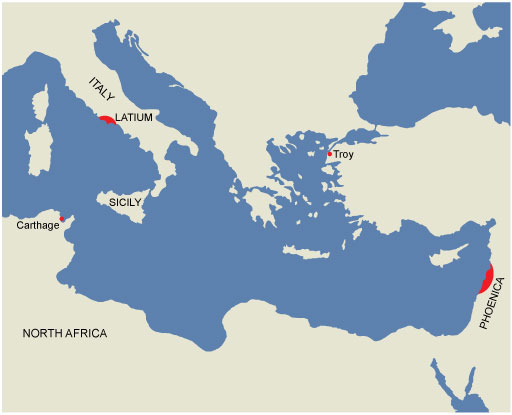2 A brief summary of the Aeneid
The poem opens with the Trojan fleet sailing towards Italy, when they are shipwrecked by a storm on the coast of north Africa, caused by Juno, queen of the gods, who hates them and is trying to prevent them reaching Italy and fulfilling their destiny. Here they encounter Queen Dido, leader of the Carthaginians, who are recent immigrants from Phoenicia (modern Lebanon and Syria), and are founding a new city, Carthage (Book 1). (The map in Figure 2 shows the key places mentioned in the poem.) Aeneas tells Dido of the destruction of Troy (Book 2), and his subsequent travels around the Mediterranean (Book 3). He and Dido soon fall in love, but Aeneas is in danger of forgetting his mission in Italy, so the king of the gods, Jupiter, sends his messenger Mercury to remind him of his duty. Aeneas’ sudden departure leaves Dido devastated, and she commits suicide and pronounces eternal hatred between the future Romans and the Carthaginians (Book 4). After a stop in Sicily (Book 5), Aeneas travels to the underworld to speak to the ghost of his father, and he sees there the souls of the future great Romans (Book 6). He is then finally able to arrive in Italy, where he is initially welcomed by the local king Latinus, who promises him his daughter Lavinia’s hand in marriage to seal peace between Trojans and Latins. However, other Italians resent this arrangement, including Latinus’ wife Amata and the Italian prince Turnus, who hoped to marry Lavinia himself. War soon breaks out between the Trojans and the Italians, to Aeneas’ dismay (Book 7). Aeneas visits another local king, Evander, whose city is built on the site of the future Rome, and Evander agrees to ally his people with the Trojans and sends his son Pallas with Aeneas for his first experience of war. Pallas is presented as a sympathetic character: a brave young man whose life is just beginning, and Aeneas feels a strong affection for him (Book 8). The war in Italy continues to rage (Book 9) and Pallas is killed by Turnus, causing a furious response in Aeneas (Book 10). Aeneas agrees to a temporary truce, and suggests he and Turnus should meet in a duel, to avoid any more loss of life, but while the Italians are debating this, war breaks out again (Book 11). Turnus finally agrees to meet Aeneas in single combat, but Juno arranges for the truce to be broken. However, when Jupiter persuades Juno to give up her hatred of the Trojans and accept the Roman destiny, she removes her protection from Turnus. He and Aeneas meet again on the battlefield, and Aeneas wounds Turnus, who begs for mercy. Aeneas is on the point of sparing him when he sees that Turnus is wearing the belt of Pallas, and kills him in a fit of rage (Book 12).

